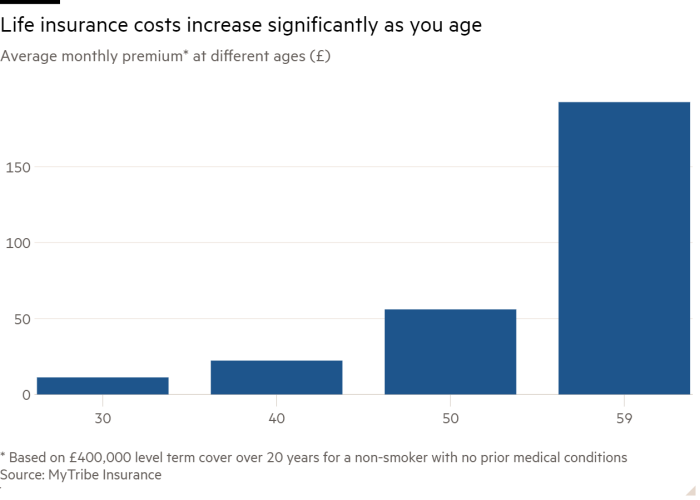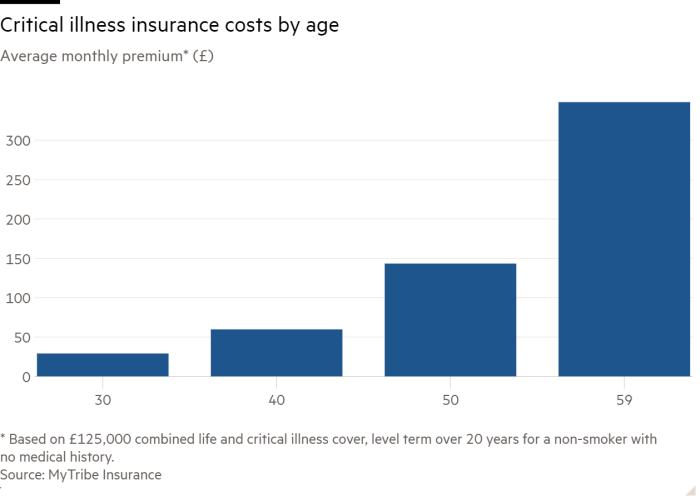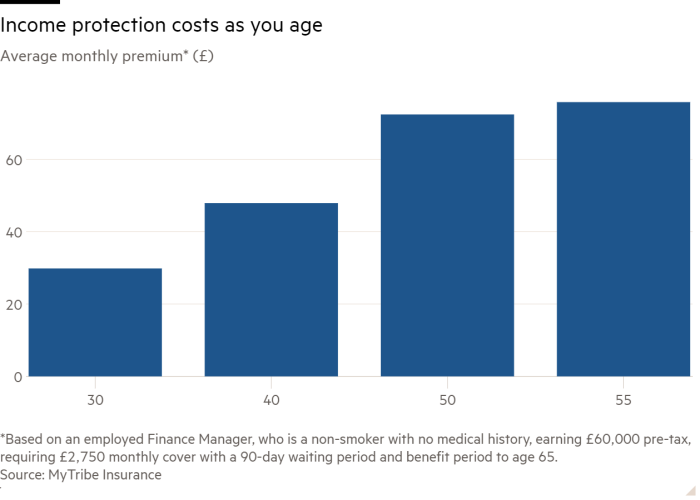Kevin Carr has had a long career in the insurance industry, and even he admits to stumbling into spending too much on protecting his family.
When his financial adviser reviewed his spending recently, he was told his level of protection insurance — products such as life insurance or income protection cover that are designed to secure your family financially — was a bit “toppy”.
“Looking at what’s going on our mortgage, Isa and other spending, he told us we were spending too much money on protection [compared with other families in similar positions]”, says Carr, 49, and the chief executive of Protection Review, a website that reviews the protection insurance industry.
Last year, 247,000 people took out income protection insurance, a record high and a 16 per cent increase on 2022, according to new figures from the Association of British Insurers. At the same time, sales of standalone critical illness cover were almost four times higher than 10 years ago.
In August, the Financial Conduct Authority, which regulates insurers, announced it was launching a market study into how protection products are sold — which are offered mainly through intermediaries such as IFAs and mortgage brokers. It is concerned products, especially those aimed at “vulnerable” customers, may not be structured fairly, and do not provide value for money.
Worries about the level of competition in the market have increased since the recent exit of large insurers such as Aegon, Canada Life and AIG. The watchdog says it will look into “potential conflicts of interest” between insurers and intermediaries, stating it has seen examples of intermediaries encouraging customers to switch unnecessarily to earn repeat commission.
It is an investigation that is “long overdue”, says Tim Hogg, director at consumer group Fairer Finance. “Market failures in pure protection are leading to harm for existing customers . . . The nature of competition in this market has led to intermediaries sometimes receiving what appear to be high commissions, resulting in lower value products for consumers.”
While a few ‘insurtechs’ are entering the market to shake it up a little, “there’s not a lot of incentive for insurers to be different,” says Carr. “First-mover disadvantage is an issue — either it doesn’t work or rivals copy it. So there’s a lack of innovation and strategy development.”
When the FT asked readers if they had ever taken out insurance policies they regret, one told us that, after recently moving jobs at 62, he will not have death in service benefit or a decent level of sick pay for the first time in 20 years, so has had to buy his own. “Most online searches make you put a phone number in even if you prefer to correspond via email,” he says. “It feels like a hard sell from sales people [and] makes me wary of the cover and companies concerned.”

But while many are worried they may be overpaying or have too much cover, the reverse is also often true. Financial advisers warn of widespread underinsurance — especially among those with chronic conditions. With too many people buying the wrong type of protection cover, clients can be left with overlapping policies or have large gaps that can lead to problems in later life.
“I see clients that have multiple life cover policies running together, where they are over-insured at the moment, but all seem to end at a different time,” says Naomi Greatorex, managing director at Heath Protection Solutions. “This can mean they are over-insured in their younger years, and underinsured in the later, and could be said, more risky years.”
Alan Knowles, managing director at Cura Financial Services, says: “The order in which people usually buy protection insurance is: one, life insurance; two, critical illness; three, income protection. Yet the likelihood of a claim . . . is the complete reverse.”
The reason advisers put income protection at the top of the hierarchy of needs is not only to protect your family. “Your income is what allows you to continue to keep to your retirement plan, and to grow your savings and pensions,” says Greatorex.
But how much protection do you really need? And is it ever reasonable to say “I don’t need any at all”?

Sometimes, over-protection is obvious, says Knowles. “An example would be someone earning £20,000, living in rented accommodation, taking out £2mn life cover for their partner. This would be 100 years of their annual income so is definitely over the top.”
A less obvious, but more common, risk is doubling up on income protection with an employer, by running an individual policy too. This is because you are only allowed to cover your income once, usually up to the maximum of 60 per cent of your gross income. If someone’s work policy covered 30 per cent of their income, for example, their personal policy could only cover up to another 30 per cent.
“If you have more than one income protection insurance policy, or the one you have is based on a higher wage you’ve had in the past but no longer have, you could be over-insured,” says Chris Steele, founder and editor of educational website MyTribeInsurance.co.uk. The self-employed need to be especially careful, as income can drop over a number of years, especially if you start to work on a part-time basis.
31%Proportion of financial advisers who say their clients had taken out the wrong type of protection before seeking advice, according to MetLife UK
People can also be caught out by inflation, says Greatorex. If you take out the maximum 60 per cent protection and your cover rises in line with RPI while your income does not keep pace, at claim stage you could find yourself over-insured.
Advisers say it is worth checking cover is good value periodically as premiums have reduced over the years — but watch out for changing underwriting practices too.
“With life insurance and critical illness cover, insurers have recently changed what they ask and how they treat people that used to smoke,” says Steele. Until recently, people would be asked if they had smoked, vaped or used nicotine replacements in the past 12 months, he says. Now, they may be asked if they used to smoke or vape in the past too, and their premium loaded to account for that.
The FCA study will primarily focus on four types of protection products: term assurance (which is life insurance that lasts for only a specific amount of time); critical illness cover; income protection; and whole of life insurance, including policies for the over-50s that offer guaranteed acceptance.
Johnny Timpson is a member of the Financial Services Consumer Panel and a Financial Inclusion Commissioner and sees problems with over-50 plans, also marketed as funeral plans. “You pay much more for the ‘reward’ of not having a medical. But if the policy was underwritten you may get significantly more cover at the same cost or the same level of cover at lower cost.”

“Seven years ago, I was diagnosed with Type 2 diabetes. It was a bit of a shock,” says FT reader David Ellison, 55, from Milton Keynes. After considering taking out life insurance, he decided to buy a policy to pay out £40,000 as a financial cushion to help support his wife should he die within the next 15 years.
Last year, he approached six major insurers and was quoted premiums of £80-£100 a month because of his condition. But then he managed to find a policy with the same level of cover for £43 a month with Blueberry Life, a new ‘insurtech’ company, which specialises in insuring people with diabetes and was able to tailor the cover to his specific blood-sugar levels.
“I think insurance is a necessary evil,” he says. “It might be 15 years of £43 a month that I never see again. But it’s peace of mind.”
Advisers say clients can often fail to change protection as they go through life events that can affect the amount of income needed, such as health diagnosis, divorce or their children becoming adults — be warned, though, Timpson adds: “You’re now likely to have dependent children for longer than you think. My eldest child is 38 but in a vocational career that means she may from time to time still need help with rent.”

Another development is when people pay off their mortgage, which may lead some to ask: am I too wealthy for protection insurance?
“Once people have paid off their mortgages and have sufficient assets invested to enable them to fund their financial future without relying upon income or having to save more, they often feel it’s a waste of money to pay insurance premiums for life cover or illness cover,” says Olivia Bowen, partner at Castlefield.
In these circumstances, advisers like Bowen can undertake cash flow forecasting to help clients be content that their assets will be sufficient.
Knowles, however, is wary of saying that you can be too rich for insurance: “The more you earn, the more you normally spend and therefore the bigger the impact if something serious happens . . . at least for most other than the super-rich.”

Additionally, later in life there can still be needs for life insurance, especially for those with sizeable estates. A policy that pays to children once both parents pass away can help with inheritance tax (IHT) bills. It is also possible to insure gifts made to children during your lifetime, where there can be a tax liability, normally for seven years from the gift being made. A policy could give the children the funds to pay the gift tax if death occurs within this timeframe.
The solution can be a whole-of-life policy to the value of the potential IHT liability, written in trust for the children (or other beneficiaries). Justin Blower at Schroders says: “It can be expensive — thousands of pounds a year depending on the health and level of cover — but what you pay in can be less than the benefit.”
In the end, when we asked FT readers to share their experiences of protection insurance, several told us they thought of it like a kind of bet. “Insurance companies are betting you survive. We are betting we are going to die or suffer life-changing circumstances,” said one.
But, it is a bet, others suggested, that is hard to feel too bad about losing. “We had a 25-year joint life insurance policy which ended last year, and here we are both still ticking along,” one told us. “I suppose we should probably be grateful for the fact.”











